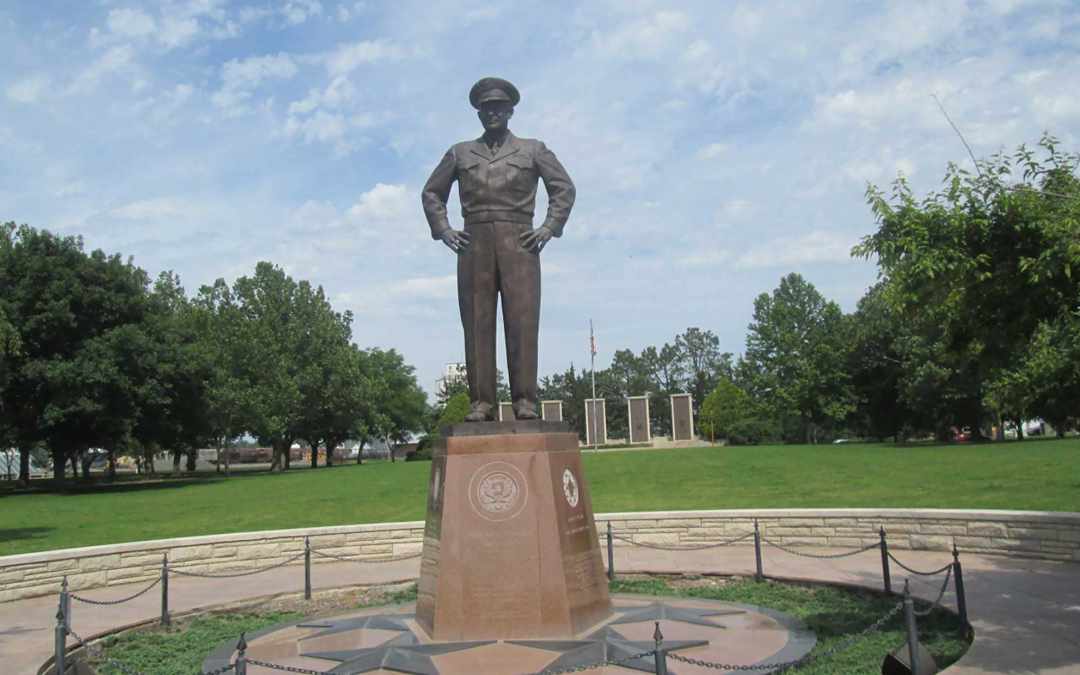February 2022
Cover Story
Hail to the Chief
Presidential libraries seek to inform, preserve leaders’ legacy
by Corbin Crable
Presidents’ Day
This Presidents’ Day, stick to your New Year’s resolution of taking the time to learn something new and take advantage of a visit to one of the presidential libraries and museums in your state.
Discover Vintage America’s coverage area spans multiple states (Missouri, Kansas, Iowa, Illinois, Nebraska, Oklahoma, Colorado, and Arkansas), and there exists a network of 13 presidential libraries, all managed by the National Archives. Of those 13 libraries, more than a third are located in one of our coverage states. In this issue, we’ll introduce you to each of them.
Each of these institutions tells the story of a regular man who went on to occupy the highest political office in the country. Each helped to shape the world in which we live today. They made great strides for our country, and despite their flaws, went on to cement their own legacy for generations to come. I encourage you to visit one of these libraries near you and learn the story of your own hometown leader
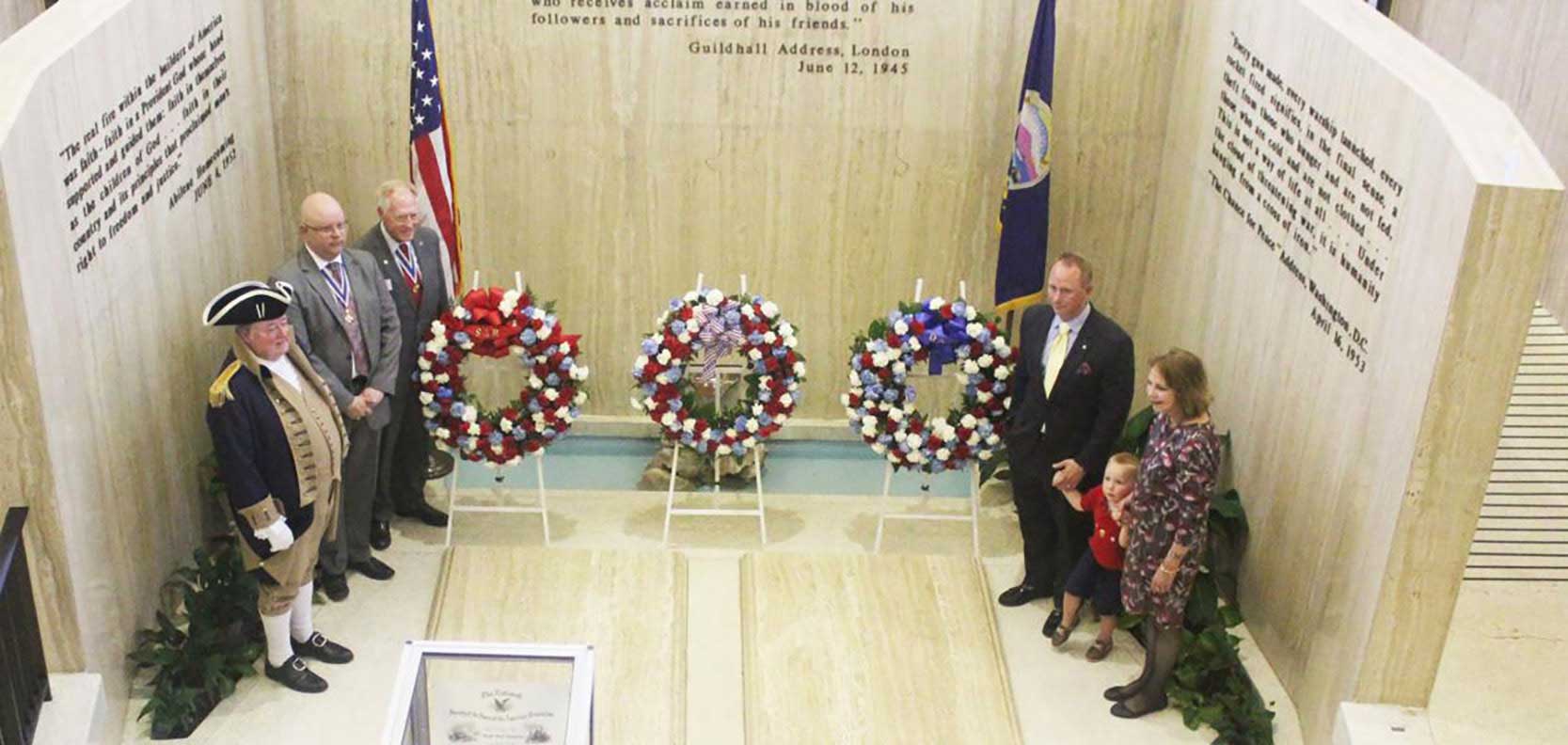
Place of Meditation ... Eisenhower resting place
State dignitaries and members of the Eisenhower family attend a grave marking ceremony in June 2018 at the Place of Meditation, where the former president and former First Lady Mamie Eisenhower are buried, on the grounds of the Eisenhower Presidential Library, Museum & Boyhood Home in Abilene, KS. (Image courtesy of The Abilene Reflector-Chronicle)
IOWA’s Presidential Library
Herbert Hoover (1874-1964)
31st President of the United States (Republican, 1929-33) Visit: The Herbert Hoover Presidential Library and Museum (West Branch); www.hoover.archives.gov
- Herbert Hoover, the only U.S. president to hail from Iowa, is perhaps best known for serving as the Commander-in-Chief who became the scapegoat of The Great Depression.
- Historians consistently rank Hoover in the bottom one-third of presidents in terms of popularity. Before his presidency, Hoover was known as “the Great Humanitarian,” who enjoyed a reputation as an eager public servant who served as the head of the Food Administration during World War I.
Highlights of the Hoover Administration:
- The Great Depression – the biggest economic disaster in the country’s history – began in 1929 and lasted for more than a decade.
Highlights of the Herbert Hoover Presidential Library and Museum:
- Currently, the museum features an online exhibit titled, “A World of Thanks: World War I Belgian Embroidered Flour Sacks.” Learn more about the trend of using flour sacks as a fashion statement in this issue of Discover Vintage America.
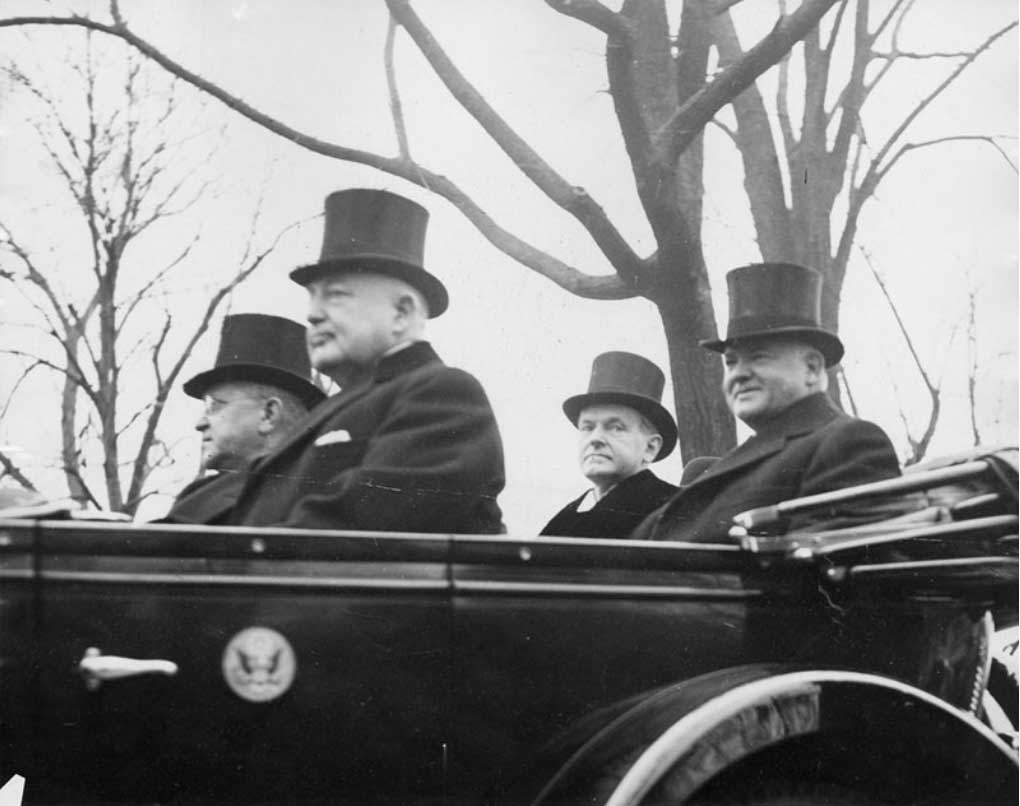
Inauguration ceremonies President-elect Herbert Hoover
President Coolidge rode with President-elect Herbert Hoover to the Capitol for the Inauguration ceremonies, March 4 1929. (Photo courtesy Hoover.archives.gov.)
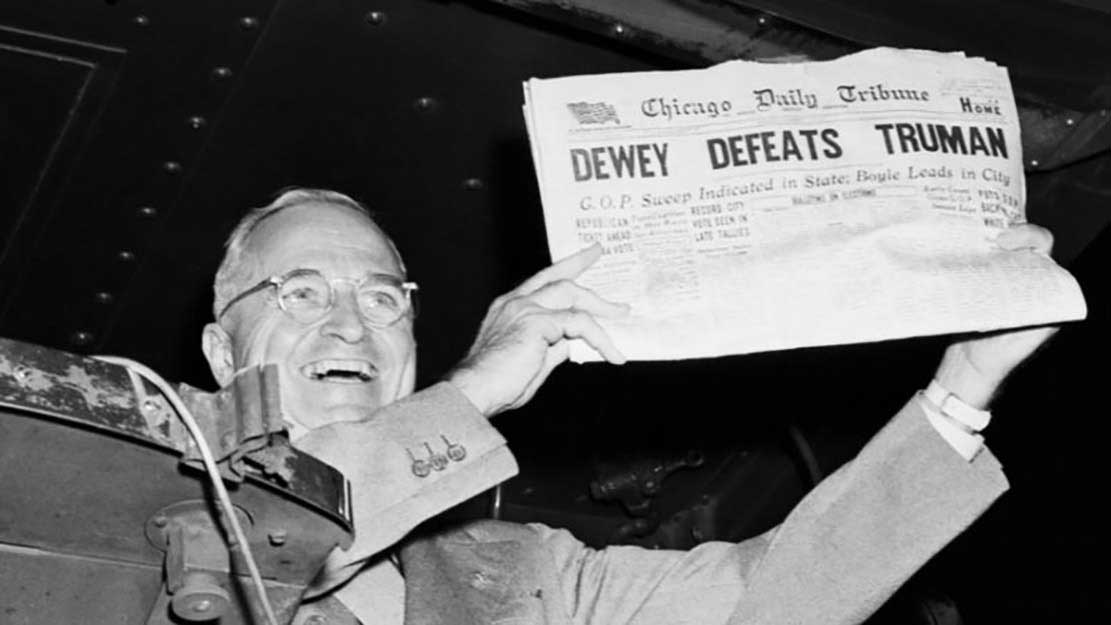
printed a headline proclaiming Dewey’s victory
Editors at The Chicago Daily Tribune were so confident that Thomas Dewey would defeat incumbent Harry Truman for the presidency on Election Night in 1948 that the newspaper printed a headline proclaiming Dewey’s victory before the results had been announced. Of course, Truman won a full, elected term, and original copies of the erroneous newspaper sell for thousands of dollars online. (Image courtesy of History.com)
MISSOURI Presidential Library
Harry S Truman (1884-1972) 33rd President of the United States (Democrat, 1945-1953) Visit: The Harry S Truman Library and Museum (Independence); www.trumanlibrary.gov
Truman became president in April 1945, following the death of Franklin D. Roosevelt, who had just begun an unprecedented fourth term. Truman had a folksy familiarity to him that clashed with the formality required of the new office he now occupied – he was known for playing poker and swilling bourbon, and Washington insiders viewed the Missouri native as crude.
Highlights of Truman’s presidency:
- The first major test of Truman’s new presidency happened quickly, as another Axis power, Japan, refused to surrender to American forces. Truman authorized the dropping of the first atomic bombs on the Japanese cities of Hiroshima and Nagasaki in early August, killing more than 100,000 people.
- Saw the enactment of The Marshall Plan, designed to rebuild postwar Europe
Recognition of Israel as its own independent nation in 1947 - The U.S. entered the Korean Conflict in 1950, during which North Korea’s army invaded the South. The conflict continued with a deeply unpopular Truman eventually dismissing U.S. Gen. Douglas McArthur for attempts to escalate the war. The conflict ended in 1953.
Highlights of the library and museum:
- Opened in 1957, the library and museum completed a massive $29 million renovation in late July 2021 and reopened to the public after having been closed for two years.
KANSAS Presidential Library
Dwight D. Eisenhower (1890-1969) 34th President of the United States (Republican, 1953-61)
Visit: The Dwight D. Eisenhower Presidential Library, Museum & Boyhood Home (Abilene); www.eisenhowerlibrary.gov
Dwight D. Eisenhower came to the White House a familiar figure to the American public. As an Army General in 1944, Eisenhower led U.S. forces during the Normandy invasion.
Highlights of the Eisenhower Administration:
- Brought forward the armistice that ended the Korean Conflict in 1953
Authorized the U.S. Highway system - Signed into law the 1957 Civil Rights Act
- Saw both Alaska and Hawaii enter into U.S. statehood
- Sent federal troops to enforce court-ordered integration of Little Rock Central High School
- Signed the bill creating the National Aeronautics and Space Administration
Highlights of the Dwight D. Eisenhower Presidential Library, Museum & Boyhood Home:
Two of the most fascinating pieces in the permanent collection are an original slice of Dwight and Mamie Eisenhower’s wedding cake (preserved since 1916) and a handwritten recipe for Mamie Eisenhower’s “Million-Dollar Fudge,” a treat for which the First Lady was known.
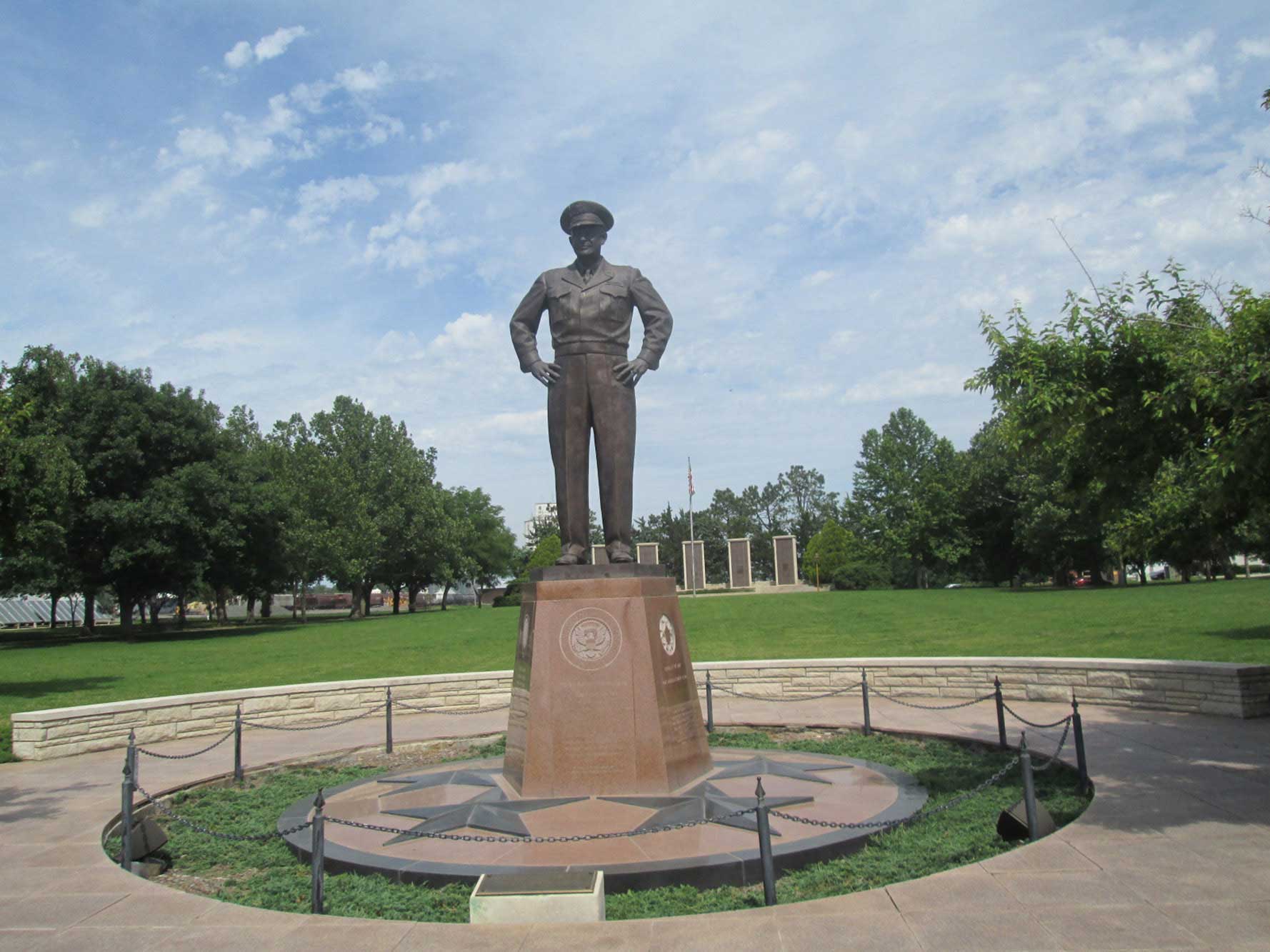
A statue of Dwight. D. Eisenhower
A statue of Dwight. D. Eisenhower greets visitors on the grounds of the Dwight D. Eisenhower Presidential Library, Museum & Boyhood Home in Abilene, KS. (Image courtesy of The Eisenhower Library)
ARKANSAS Presidential Library
Bill Clinton (1946- ) 42nd President of the United States (Democrat, 1993-2001) Visit: The William J. Clinton Presidential Library and Museum (Little Rock); www.clintonlibrary.gov
- Clinton served as an Arkansas attorney and the state’s governor before becoming the first Democratic president since Jimmy Carter. Well remembered for his controversial relationship and personal misconduct with White House intern Monica Lewinsky, the Clinton years nevertheless saw the country enjoy a period of economic success and a strong relationship with foreign countries. Clinton left the White House in 2001 with the highest-term end-of-approval rating of a U.S. President since FDR.
Highlights of the Clinton Administration:
- Signed the Family and Medical Leave Act (FMLA) of 1993
- Signed the Brady Bill into law; the legislation mandated federal background checks on those who purchase firearms in the U.S.
- Implemented “Don’t Ask, Don’t Tell,” which allowed gays and lesbians to serve in the U.S. military provided they kept their sexual orientation under wraps
- Impeached in late 1998 by the House of Representatives for lying and covering up his relationship with Lewinsky
Highlights of the William J. Clinton Presidential Library and Museum:
- A permanent exhibit of items gifted to Clinton by world leaders throughout his two terms as president
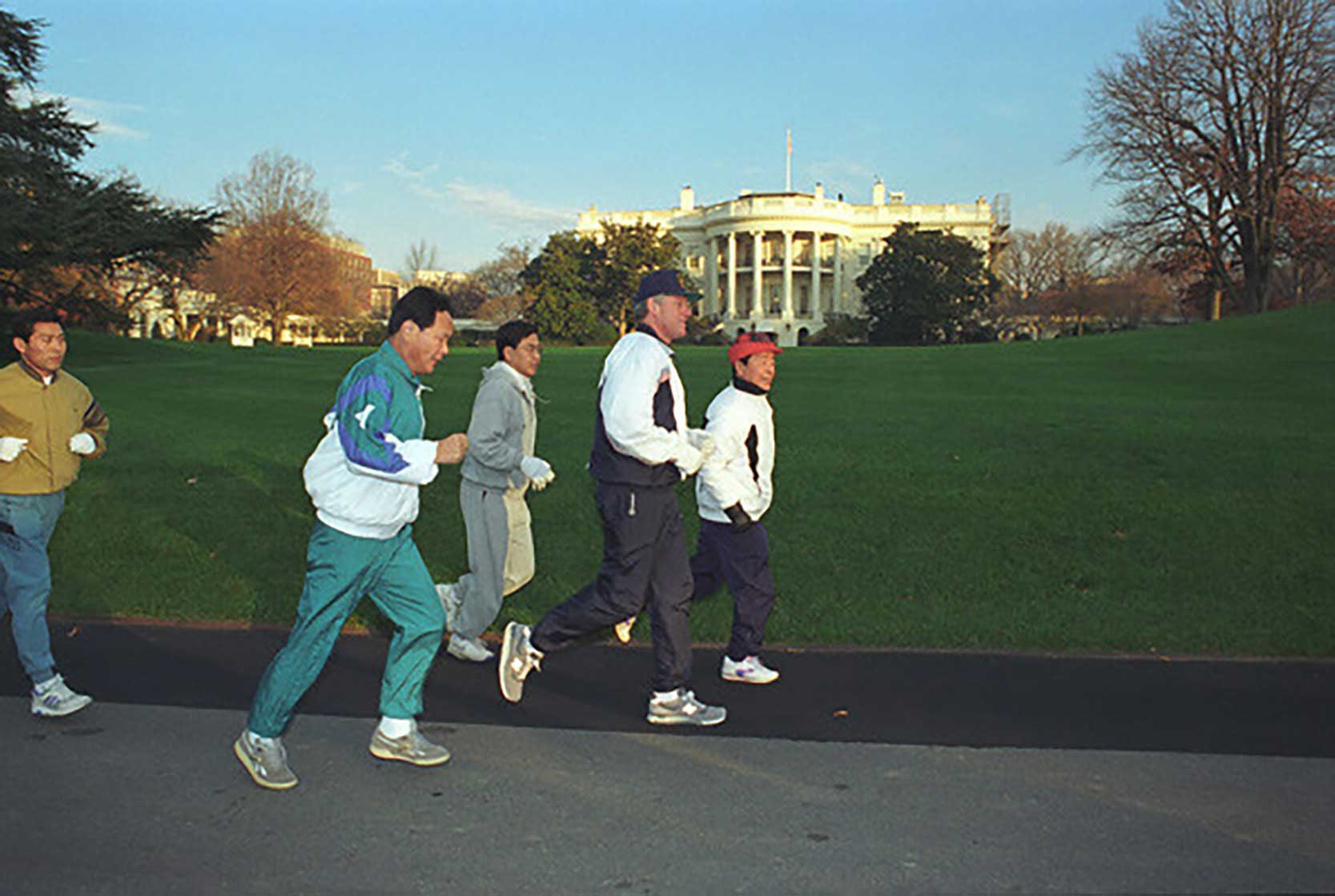
President Bill Clinton and South Korean President Kim Young-Sam jog
President Bill Clinton and South Korean President Kim Young-Sam jog past the White House in November 1993. (Image courtesy of The U.S. National Archives)
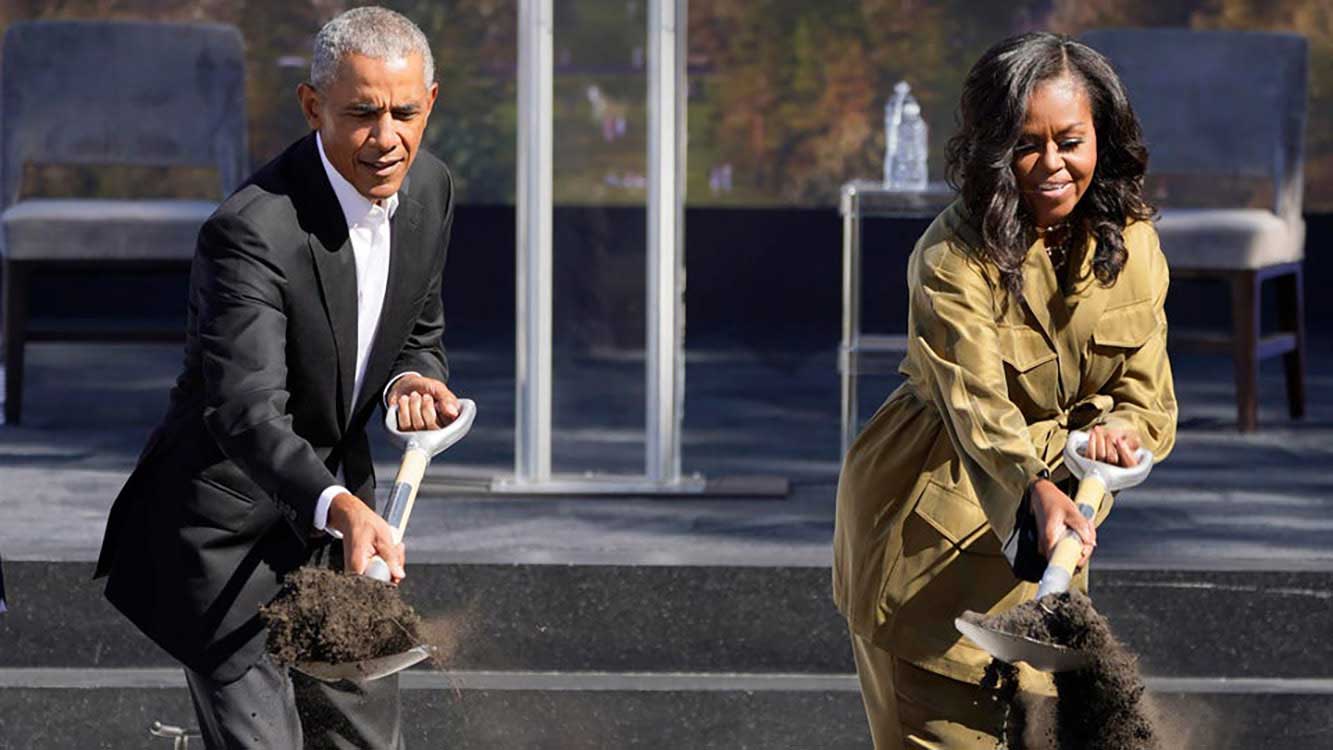
Groundbreaking Ceremony for The Barack Obama Presidential Center in Chicago
Former President Barack Obama and former First Lady Michelle Obama attend a groundbreaking ceremony for The Barack Obama Presidential Center in Chicago in September 2021. The building is separate from Obama’s official presidential library, which is the first to go completely online. (Image courtesy of ABC7)
ILLINOIS Presidential Library
Barack Obama (1961- ) 44th President of the United States (Democrat, 2009-17)
Visit: The Barack Obama Presidential Center (Chicago, currently under construction); www.obamalibrary.gov
- Elected as the first African-American President in the nation’s history, Obama was born in Hawaii but spent some of his youth in Illinois. He served as a U.S. Senator representing that state from 2006-08.
Highlights of the Obama Administration:
- Signed the Affordable Care Act (“Obamacare”) into law in 2010
- Signed off on the military raid that led to the death of al-Qaeda leader Osama bin Laden in 2011
- Joined with other nations to enter into a Joint Comprehensive Plan with Iran, which aimed to prevent Iran from obtaining further nuclear weapons and committed the country to monitoring all Iranian nuclear activities
Highlights of the Barack Obama Presidential Center:
Although the presidential center will eventually be located in Illinois, the accompanying Barack Obama Presidential Library is the first fully digital presidential library. According to the National Archives, an estimated 95 percent of the administration’s presidential records originated in digital form. The library can be found online at www.obamalibrary.gov. The brick-and-mortar presidential center, currently being built, is managed by The Obama Foundation, not the National Archives.
And an honorable mention goes to:
Gerald R. Ford (1913-2006) 38th President of the United States (Republican, 1974-77) Visit: The Gerald R. Ford Presidential Library (Grand Rapids, MI) www.fordlibrarymuseum.gov/
- Although this library is located in Michigan, Ford himself was born in Omaha, NE.
- Ford himself became ripe fodder for late-night talk show hosts, portrayed as a bumbling, accident-prone politician, who was seen as a mere placeholder for the office of the presidency.
Highlights of the Ford Administration:
- Ford was administered the oath of office upon the resignation of his predecessor, Richard Nixon, on Aug. 9, 1974. In his first address to the nation, the new president declared, “Our long national nightmare is over,” a reference to the Watergate scandal that plagued Nixon’s second term. Ford offered Nixon a presidential pardon for his role in Watergate.
- U.S. forces withdrew from Vietnam on April 30, 1975, during the Fall of Saigon, marking the official end of the Vietnam War
Highlights of the Gerald R. Ford Presidential Library and Museum:
- A special exhibit, “Women in Uniform,” which documents the history of women serving in the U.S. Navy, will be housed at the library until May 22, 2022.
Source: The National Archives, www.archives.gov
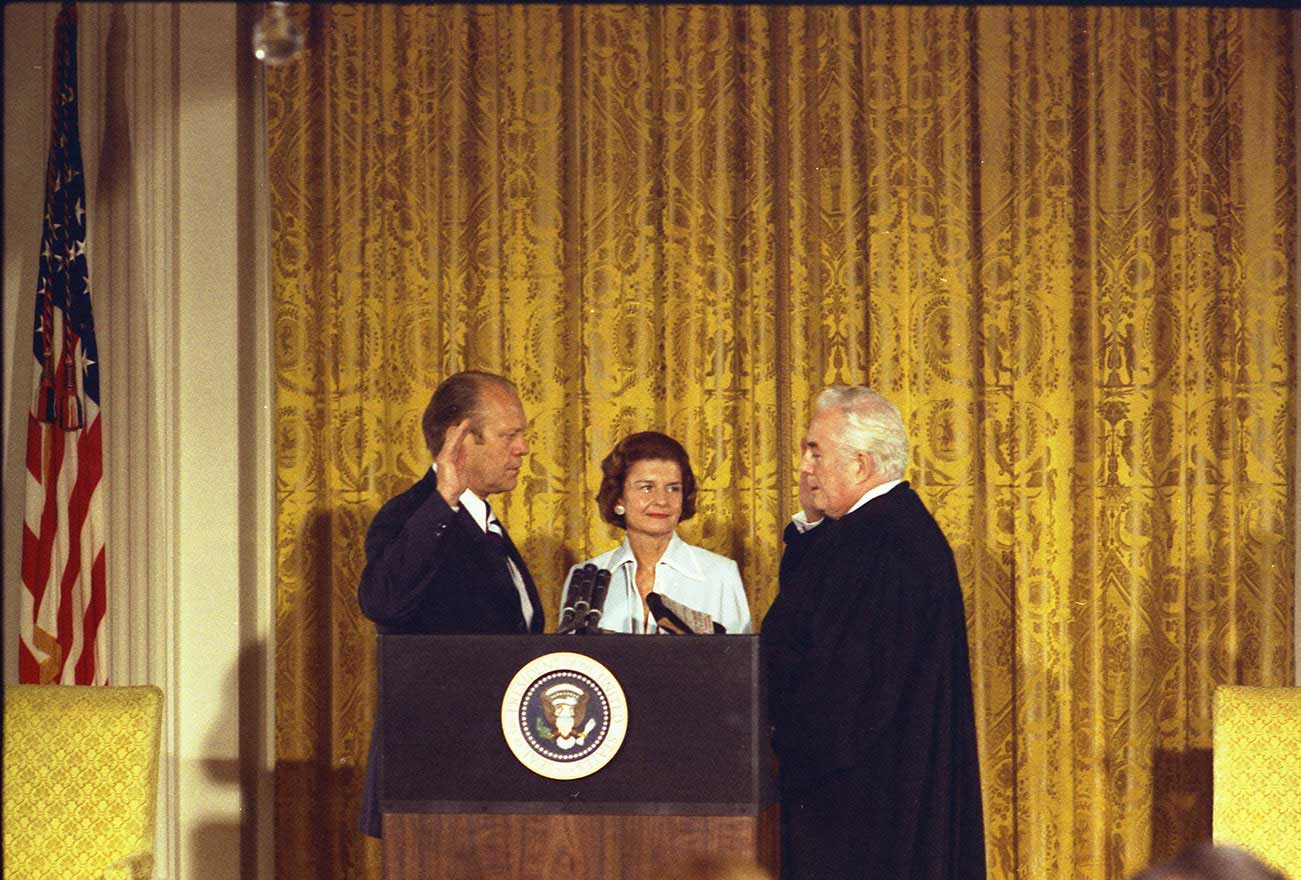
Gerald Ford takes the oath of office
Gerald Ford takes the oath of office on Aug. 9, 1974, following the resignation of Richard Nixon as his wife, Betty, looks on. Ford was born in Nebraska, but his presidential library is located in Michigan. (Image courtesy of The Gerald R. Ford Presidential Foundation)


